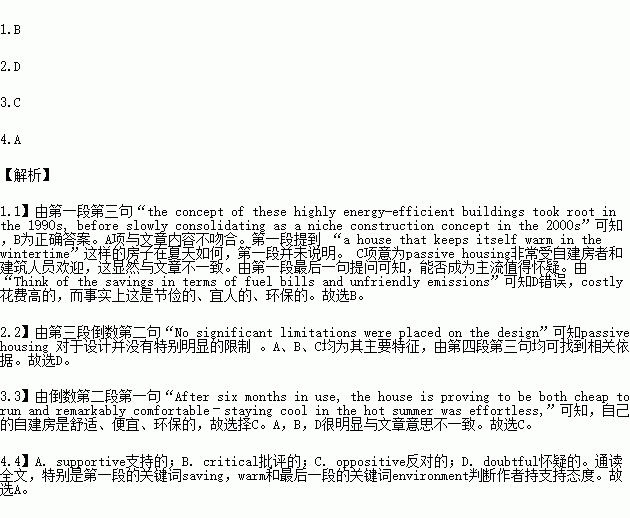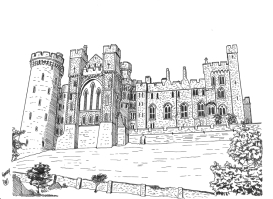题目内容
Imagine a house that keeps itself warm in the wintertime. Think of the savings in terms of fuel bills and unfriendly emissions. Such houses in fact exist, called “passive houses”. The concept of these highly energy-efficient buildings took root in the 1990s, before slowly consolidating as a niche construction (生态位构建) concept in the 2000s. Are passive houses now actively moving into the mainstream as sustainable buildings?
For Brian Mc Garry, an economics lecturer who built a family house based on passive housing criteria in the Pyrenees this year, the arguments look convincing. As his first full winter in the low energy house draws in, we asked him to keep us informed. Do passive houses work?
I had never heard of a passive house in February 2012, when I purchased a plot of land. Nor did I expect that I would be persuaded to build a pre-constructed, custom-designed house based on energy-efficient passive house criteria. It promised to be easier and quicker to build, cheaper to run, and more comfortable to live in. The objective was to incorporate the fundamental concepts of passive energy management into my project: an airtight and highly insulated building envelope; large south facing double or triple-glazed windows (if possible, filled with argon gas) that passively capture the energy of the sun; a heat recovery ventilation system to provide fresh air; and a simple, low-cost heating system consisting of a modern wood-burning stove, a bathroom heater and a portable radiator backup for when the sun doesn’t shine and temperatures decline. No significant limitations were placed on the design, and it had excellent environmental credentials. Moreover, the cost was no more than a conventional build.
After six months in use, the house is proving to be both cheap to run and remarkably comfortable–staying cool in the hot summer was effortless, as long as the windows were shuttered or shaded from the sun. Nowstaying warm in the cold, high-altitude December climate also seems easy, so far.
Winter arrived in force in the Pyrenees in November, with abundant snowfalls and temperatures as low as minus 8° Celsius. Though early days, the house has responded well: the stove is lit during cold evenings but the portable radiator has not yet been needed. This type of construction seems not only to make economic and environmental sense, but to enhance our quality of life, too.
1.We can learn from Paragraph one that passive houses __________.
A. consume extra energy to keep warm in winter and cool in summer
B. had been introduced for a decade before the birth of the theory
C. appeal to both the self-builders and those constructors
D. refer to a certain house comfortable, costly and also pleasing
2.Regarding the passive energy management, the houses have characteristics EXCEPT _______
A. using south-facing windows to take in solar energy
B. Providing energy for taking a shower when it’s rainy
C. supplying fresh air with a special heat recovery system
D. placing more demands and restrictions on the design
3.How did Brian McGarry find his self-built passive house?
A. very unaffordable
B. Energy-consuming
C. comfortable to live in
D. Awkward to use
4.What is the writer’s attitude towards the passive housing?
A. supportive B. critical
C. oppositive D. doubtful
短文改错
下面短文中有10处语言错误。请在有错误的地方增加、删除或修改某个单词。
增加:在缺词处加一个漏字符号(∧),并在其下面写上该加的词。
删除:把多余的词用斜线(\)划掉。
修改:在错的词下划一横线,并在该词下面写上修改后的词。
注意:1. 每处错误及其修改均仅限一词;
2. 只允许修改10处,多者(从第11处起)不计分。
例如: It was very nice to get your invitation to spend ∧ weekend with you. Luckily the I was completely free then, so I’ll to say “yes”. I’ll arrive in Bristol at around 8:00 p.m. am in Friday evening. on |
Bailey is an only child, and first boy born into a family that was accustomed to raise girls. He has grandparents who love to buy his “boy” toys and spoil him like crazy. Bailey is fortunate enough to have multiple gaming system and more toy cars than someone he knows. He has always been kind-hearted and generously with older kids and has never had a problem inviting them to join his fun. However, when it came to younger kids, he falls short. He get easily frustrated when they play with his favorite toy cars or fail to understanding how to play his video games with.



